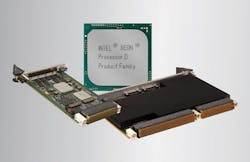Curtiss-Wright enables use of VxWorks with Xeon D processor in HPEC applications
ASHBURN, Va. — The Curtiss-Wright Defense Solutions division in Ashburn, Va., is announcing a performance breakthrough for high-performance embedded computing (HPEC) by enabling use of Wind River VxWorks real-time operating system software with the Intel Xeon D high-performance processor.
Software drivers in Curtiss-Wright’s board support package (BSP) for the Intel Xeon D processor enable VxWorks to access the Intel Xeon D processor’s QuickData Technology DMA engine, freeing the multi-core processor from devoting critical resources to communications handling.
Curtiss-Wright may have a solution for using VxWorks real-time software with the popular Intel Xeon D in high-performance embedded computing.
This provides HPEC system designers with the deterministic hard-real-time attributes of VxWorks, access to the Intel Xeon D processor architecture for multi-core and multi-board HPEC systems, and VxWorks support for the Intel Xeon D processor’s QuickData Technology DMA engine.
Before this, designers who wanted to use the Intel Xeon D processor had little or no support for the VxWorks real-time operating system. Instead, they typically used Linux, which has issues with performance determinism. “With Linux there is a fair amount of code overhead, so you have to give yourself margin, explains Marc Couture, Curtiss-Wright’s director of engineering. “In some EW techniques, however, you are worried about nanosecond accuracy. VxWorks is where that really shines. Timing is everything in many EW systems.”
As a result, some aerospace and defense systems designers were switching to the Linux operating system to take advantage of the Linux support for the Xeon D.
“Any Intel processor out of the box will give you Linux support, but for defense applications that use VxWorks for real-time capability, they need determinism,” says Denis Smetana, Curtiss-Wright’s senior product manager of DSP products. “Anything that delays the processor also delays your response to a real-world event that could be a life-or death matter.”
This software support can facilitate use of the Intel Xeon D and VxWorks operating system for aerospace and defense hard-real-time applications like electronic warfare (EW), radar, signals intelligence (SIGINT), and intelligence, surveillance, and reconnaissance (ISR).
Curtiss-Wright’s software support enables the systems integrator to match the equivalent development system he needs to the appropriate stage of his program, while enabling application transfer between the stages with minimal effort, Curtiss-Wright officials say.
Curtiss-Wright’s software also supports Mellanox Ethernet controllers, previously available only for Linux. These controllers deliver 40-Gigabit Ethernet on Curtiss-Wright’s Fabric40 CHAMP-XDx modules rated at about 37 gigabits per second near line-rate.
The first Curtiss-Wright single-board computers involved in this software support for using VxWorks with the Intel Xeon D processor are the Curtiss-Wright CHAMP-XD1 3U OpenVPX and CHAMP-XD2 6U OpenVPX digital signal processing (DSP) modules.
For more information contact Curtiss-Wright Defense Solutions online at www.curtisswrightds.com.

